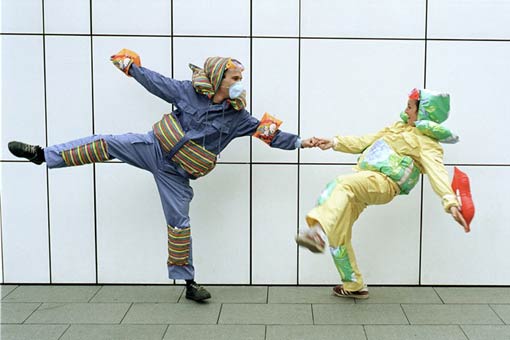 |
October
2003 volume 1, issue 2 |
| |
|
|
Dark Matter, Las Agencias, and the Aesthetics of Tactical Embarrassment 1 Gregory G. Sholette (continued 1 2 )
In so far as this shadowy realm is unburdened by the ironic posturing or careerism of the high-art tradition it fulfills what is arguably a widespread tendency to participate in creative labor not dictated by necessity, but by desire. And while one can question the a-political nature of most of this work, or following Adorno dismiss it outright because its “low” subject matter reflects, rather than negates the manufactured escapism of mass culture, I prefer instead to focus on the self-directed and counter-productive nature of this activity and argue that structurally speaking, this largely invisible, creative work is closer in spirit and market value to politically engaged, activist art than either of these are to commercial or fine art. In this sense, and this is crucial for my argument, creative dark matter is strongly related to the practices of artists who self-consciously work outside the parameters of the mainstream art world for political and socially critical reasons including, but not limited to, Yomango and Las Agencias. Nevertheless, it is the emergence of creative activism into a broader visual arena, one in which the participants become visible not only to each other but also to the centralized institutions of the art world, that presents new possibilities as well as traps. Consider for example the way a few, relatively safe "political" artists in the mid to late 1980s were selected from a far larger field of activist dark matter and permitted access to the museum. Therefore if increased visibility is a necessary strategy for political action it is not without its own danger. At the same time the need to frame this new wave of activist art in a radically different way from previous art history is conspicuous. As activist and theoretician Brian Holmes asserts: "Despite
the ideologies of resignation, despite the dense reality of governmental
structures in our "control societies," nothing prevents
the sophisticated forms of critical knowledge, elaborated in the peculiar
temporality of the university, from connecting directly with the new
and also complex, highly sophisticated forms of dissent appearing
on the streets. This type of crossover is exactly what we have seen
in the wide range of movements opposing the agenda of neoliberal globalization.
" 5 Where then are the historians of darkness? What tools will they require to move beyond a mere description of these shadows and dark practices and towards the construction of a counter-public sphere? In this short text I have, as always, attempted too much. Clearly, more research is needed on how alternative or counter economic forms link up with collective patterns of engaged art making as well as how one measures the relative autonomy of critical art practices in relation to the culture industry. One thing is clear however; the construction of a counter-public sphere will necessitate that we move away from the longstanding preoccupation with representation and towards an articulation of the invisible. To be seen, seeable, embodied, to block something from another’s view, to take as well as give away the very means of seeing, these are the new terms of battle. With it comes a new horizon filled with possibilities as well as risks. Lets hope we historians of darkness are up to the task. __________________________________________________________________ "Las
Agencias is a network of autonomous groups, working on the construction
of biopoilitical antagonism. The fields which deal with the construction
of culture and lifestyle are no longer separate from those that deal
with the construction of the political body." http://www.sindominio.net/fiambrera/web-agencias/ __________________________________________________________________ 1. This essay is based on several recent lectures and essays I have produced about art activism and informal art. For more on this concept please see, "Dark Matter, Activist Art and the Counter-Public Sphere" and "Heart of Darkness: a Journey into the Dark Matter of the Art World," available on line at http://www.artic.edu/~gshole/ 2. BBC News World Ed. Monday, 17 February 2003, 13:01 GMT at: http://news.bbc.co.uk/2/hi/europe/2765215.stm. 3. Waiting for Tear Gas a photo-essay by Allan Sekula in the book 5 Days that Shook the World: Seattle and Beyond. Alexander Cockburn, Jeffrey St. Clair and Allan Sekula. (Verso, London, NY: 2000.) 4. For an elaboration of this position please see my essay, "Some Call It Art: From Imaginary Autonomy to Autonomous Collectivity":Collectivity" published in the book Dürfen Die Das?: Kunst als sozialer Raum: Art/Education/Cultural Work/Communities, Ed. Stella Rollig and Eva Sturm, (Verlag Turia & Kant, Wien, Austria, 2002). 161-184. and also viewable on the website of the European Institute for Progressive Cultural Policies EIPCP at: http://www.eipcp.net/diskurs/d07/text/sholette_en.html 5.
Brian Holmes, "The Flexible Personality: For a New Cultural Critique,"
in Hieroglyphs of the Future: Art and Politics in a Networked Era
(Zagreb: Arkzin, 2003) also at: www.noemalab.com/sections/ideas/ideas_articles/holmes_personality.html
|
||
|
|
||
